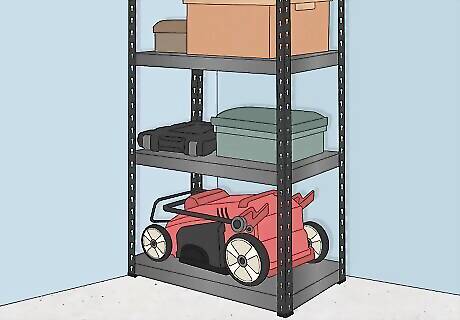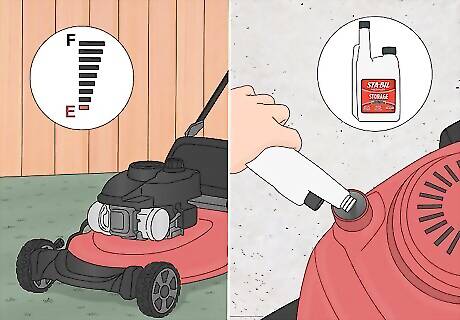
views
Where to Store a Lawn Mower in a Garage

Tuck your lawn mower in the corner so it’s out of the way. Clear out a corner of your garage so your lawn mower has enough space to fit. If your garage has corners with low, slanted walls, the space underneath is a perfect fit for your lawn mower. Keep your mower on a flat, even surface so it doesn’t leak any fluids. Some lawn mowers have handles that fold down so they’re out of the way and easier to store. Then, your lawn mower may fit underneath a shelf or cabinet. Is it safe to store a lawn mower in the garage? As long as your lawn mower is in good condition, your garage is perfect since for protecting it from severe weather or temperature changes. However, if the lawn mower gets in your way or if it’s damaged, it’s best to find a different place to store it. Can you leave gas in your lawn mower? Yes you can, as long as you use your mower again within the next couple of months. Grant Wallace, a professional landscaper, mentions, “gas that sits around inside any kind of lawn equipment over extended periods…is not great for the engine.” If you’re storing your lawn mower long-term, winterize the lawn mower first.

Keep your mower on sturdy lower shelves to maximize storage. Either buy heavy-duty garage shelves or build your own to better fit your space. Use the bottom shelf or attach a ramp to a taller platform so it’s easier to take out and put away your mower. Measure the length, width, and height of your lawn mower to make sure you get shelving that’s large enough. Check the manual for the mower’s weight as well and compare it to the shelf’s maximum capacity. Keep lawn mower attachments, oil cans, and other lawn care supplies on shelves near your mower so they’re easy to access when you need them.

Store your lawn mower vertically if the manual says it’s okay. Check the manual that came with your lawn mower to see if it’s safe to store vertically. If the manual says vertical storage is okay, then position the lawn mower upright against your garage wall so it saves more space. You can usually stand most electric mowers upright against the wall. Avoid storing gas-powered mowers vertically unless they’ve been fully drained or are labeled as “leakproof.” If you do stand the mower up, fuel and oil could leak out and become a slip or fire hazard. Install hooks on wall studs in your garage, and hang up lightweight mowers vertically so they’re off the floor. Just make sure the hooks are made to support the weight of your mower.

Put lightweight mowers on a sturdy ceiling rack to store them long-term. If you’re putting your lawn mower away for winter and want it out of the way, empty out the fluids and remove the blade. Install a rack to your ceiling joists that can support the mower’s weight. Most mowers weigh between 30–80 pounds (14–36 kg), so make sure your rack has a higher capacity. Ceiling racks make it a little more difficult to access your lawn mower, so they aren’t the best if you’re using your mower regularly. Use a storage lift to move your lawn mower up and down from the rack. Avoid installing the ceiling rack above a vehicle or walkway just in case anything falls down.
Other Places to Store a Lawn Mower

Cover the mower with a waterproof tarp if you leave it outside. Grant Wallace, a professional landscaper, recommends keeping your lawn mower under cover so it’s out of the rain. Wrap the tarp completely around the mower and secure it with bungee cords. If you’re able to, put the lawn mower on a wood pallet or spare pieces of lumber to lift it off the ground so it stays dry. Many riding lawn mowers already come with waterproof covers. Hide your mower underneath a deck or under a covered patio. If you have a gazebo or pergola in your yard, keep your lawn mower there when you’re not using it. Avoid leaving your lawn mower outside and exposed to the elements since it could get damaged or corroded.

Keep the mower under an outdoor storage tent for a portable solution. Outdoor storage tents are made from waterproof material, and offer a large, dry storage space for your mower wherever you have the space. Assemble the storage tent somewhere dry and park your lawn mower inside. Storage tents work perfectly for push mowers and riding lawn mowers.

Use a mower shed for a smaller storage unit. A mower shed is a short container made from weatherproof plastic. Place the shed in a well-ventilated area away from any heat sources. Whenever you’re not using your lawn mower, just roll it into the mower shed and secure the doors behind it. Depending on the size of your mower shed, you may be able to store lawn mower attachments and other yard tools inside as well.

Store your lawn mower in a tool shed to protect it. If you already have a shed in your yard or if you want to build one for extra storage, find some space for your lawn mower inside. That way, it’s protected from the elements and easy to access whenever you need it. Avoid putting your lawn mower in a shed that has high humidity since it could cause the metal pieces to rust or corrode faster.

Put a cover over the charging station for automatic mowers. If you have a robotic lawn mower that goes back to a charger, install a waterproof cover on top. That way, your lawn mower is more hidden when it’s not running and it’s protected from the rain.

Put the lawn mower in your basement for long-term storage. If you’re not planning on using your lawn mower regularly, like through the winter, then find a spot in your basement, such as under the stairs. Choose a spot away from any open flames, such as your furnace, water heater, or dryer. Avoid keeping gas-powered mowers in your home if there’s still fuel in the tank because it creates a fire hazard. Before you store your mower, run it until the tank is empty. If your basement has a history of flooding, put the mower on a shelf or find a different place to store it.

Rent a storage unit if you don’t have space at home. If you have a large riding lawn mower to put away for the season or if you’re just out of space at home, look for storage units near you and compare their prices. The storage unit ensures your items will be safe no matter the weather conditions. Ask your neighbors if they have any spare space in their shed or garage. You could always offer to help mow their lawn to make up for it.
Winterizing Your Mower for Long-Term Storage

Empty the gas tank or add fuel stabilizer. To empty your tank, just keep running it until the engine dies. Alternatively, pour in a chemical stabilizer that keeps the gasoline in working condition. It’s okay to leave gas in your lawnmower in between regular mowings, but the fuel starts to go bad within 3-6 months.

Disconnect the spark plug or battery. On a gas-powered mower, the spark plug is usually at the front of the engine under a rubber cover. In an electric mower, the battery is either on the top or side. Simply pull out the plug or battery so the mower doesn’t accidentally turn on while you’re storing it. If you’re having trouble finding the spark plug on your specific model, check your mower’s instruction manual. On a riding lawn mower, the spark plugs are usually connected to the back or side of the engine.

Change the oil in your mower. Look for a drain plug on the side of your mower’s engine. Slide an oil pan under the mower and undo the plug to remove the old oil. Then, pour new lawn mower oil into the compartment up the fill line. Wallace recommends changing the oil in your lawn mower about once a year to keep it in good running condition.

Clean the mower’s blade and underside. Tilt your mower up so you can access the blade and underside. Clean out the debris with a garden hose and a stiff nylon brush. If the clippings are stuck on, spray them with a pressure washer instead. Always make sure the spark plug or battery is disconnected before cleaning the blade so you don’t risk serious injuries. If the blade looks dull, either sharpen or replace it so your mower works great the next time you use it.

Change the mower’s air filter if it’s clogged or damaged. Look for the plastic cover for the air filter compartment on the side of the mower’s engine. Pull out the filter and brush off any dust or debris to clean it off. If it’s completely clogged or damaged, then install a new filter. The air filter traps particles and prevents them from getting caught in your lawn mower’s engine.

Lubricate moving parts and tighten fasteners. Wipe the areas around the wheels, axles, and blade with a clean cloth to remove any dirt. Then, apply a small amount of machine oil to keep the parts moving. If you notice any loose bolts or screws, retighten them again as well.




















Comments
0 comment